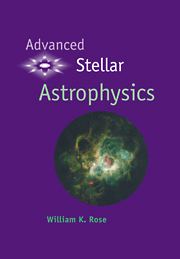Book contents
- Frontmatter
- Contents
- Preface
- 1 Star formation and stellar evolution: an overview
- 2 Introduction to the physics of stellar interiors and the equations of stellar structure
- 3 Statistical physics
- 4 Absorption processes
- 5 Stellar atmospheres, convective envelopes and stellar winds
- 6 Thermonuclear reactions and nucleosynthesis
- 7 Weak interactions in stellar interiors
- 8 Stellar stability and hydrodynamics
- 9 Binary stars, mass accretion, stellar rotation and meridional circulation
- 10 Stellar magnetic fields
- 11 White dwarfs, novae and supernovae
- 12 General relativity
- 13 Neutron stars and black holes
- Appendix 1 Physical and astronomical constants
- Appendix 2 Further comments on the Dirac equation
- Appendix 3 Mathematical appendix
- Appendix 4 Polytropes and the isothermal gas sphere
- Appendix 5 Solutions to selected problems
- References
- Index
1 - Star formation and stellar evolution: an overview
Published online by Cambridge University Press: 05 June 2012
- Frontmatter
- Contents
- Preface
- 1 Star formation and stellar evolution: an overview
- 2 Introduction to the physics of stellar interiors and the equations of stellar structure
- 3 Statistical physics
- 4 Absorption processes
- 5 Stellar atmospheres, convective envelopes and stellar winds
- 6 Thermonuclear reactions and nucleosynthesis
- 7 Weak interactions in stellar interiors
- 8 Stellar stability and hydrodynamics
- 9 Binary stars, mass accretion, stellar rotation and meridional circulation
- 10 Stellar magnetic fields
- 11 White dwarfs, novae and supernovae
- 12 General relativity
- 13 Neutron stars and black holes
- Appendix 1 Physical and astronomical constants
- Appendix 2 Further comments on the Dirac equation
- Appendix 3 Mathematical appendix
- Appendix 4 Polytropes and the isothermal gas sphere
- Appendix 5 Solutions to selected problems
- References
- Index
Summary
A short history of stellar astrophysics
Since the Sun is a star it is probably correct to say that stellar astrophysics began with Newton's well-known explanation for the Keplerian laws of planetary motion. Although J. Goodricke observed the eclipsing binary variable Algol (β Persei) in 1782, it was not until 1803 that Sir William Herschel's observations of Castor proved that two stars revolve around each other owing to their mutual gravitational attraction.
The first measurements of stellar parallax were made by F. W. Bessel and F. G. W. Struve in 1838. F. Schlesinger revolutionized stellar distance determinations in 1903 when he introduced photographic parallaxes and thereby enabled astronomers to measure parallaxes to an accuracy of about 0.01 arc seconds. K. Schwarzschild initiated photographic photometry during the years 1904–8. Photoelectric photometry of stars began shortly after the photocell was invented in 1911.
J. Fraunhofer discovered Fraunhofer absorption lines in the solar spectrum in 1814 and subsequently observed similar lines in other stars. In 1860 Kirchhoff formulated the relationship between radiative absorption and emission of radiation which is known as Kirchhoff's law. The Doppler effect and Kirchhoff's law formed the conceptual basis of early studies of stellar atmospheres. The quantum theory of blackbody radiation was introduced by M. Planck in 1900. To a first approximation most stars radiate as blackbodies with superimposed absorption and emission lines. The modern theory of radiative transfer in stellar atmospheres was initiated in 1906 by K. Schwarzschild.
- Type
- Chapter
- Information
- Advanced Stellar Astrophysics , pp. 1 - 35Publisher: Cambridge University PressPrint publication year: 1998



